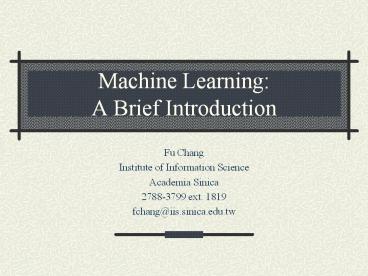Machine Learning: A Brief Introduction - PowerPoint PPT Presentation
1 / 27
Title:
Machine Learning: A Brief Introduction
Description:
Machine Learning: as a Tool for Classifying Patterns. What is the difference ... R. O. Duda, P. E. Hart, and D. G. Stork, Pattern Classification, 2nd Ed. ... – PowerPoint PPT presentation
Number of Views:53
Avg rating:3.0/5.0
Title: Machine Learning: A Brief Introduction
1
Machine Learning A Brief Introduction
- Fu Chang
- Institute of Information Science
- Academia Sinica
- 2788-3799 ext. 1819
- fchang_at_iis.sinica.edu.tw
2
Machine Learning as a Tool for Classifying
Patterns
- What is the difference between you and me?
- Tentative answer 1
- You are pretty, and I am ugly
- A vague answer, not very useful
- Tentative answer 2
- You have a tiny mouth, and I have a big one
- A lot more useful, but what if we are viewed from
the side? - In general, can we use a single feature
difference to distinguish one pattern from
another?
3
Old Philosophical Debates
- What makes a cup a cup?
- Philosophical views
- Plato the ideal type
- Aristotle the collection of all cups
- Wittgenstein family resemblance
4
Machine Learning Viewpoint
- Represent each object with a set of features
- Mouth, nose, eyes, etc., viewed from the front,
the right side, the left side, etc. - Each pattern is taken as a conglomeration of
sample points or feature vectors
5
Patterns as Conglomerations of sample Points
B
A
Two types of sample points
6
ML Viewpoint (Cntd)
- Training phase
- Want to learn pattern differences among
conglomerations of labeled samples - Have to describe the differences by means of a
model probability distribution, prototype,
neural network, etc. - Have to estimate parameters involved in the model
- Testing phase
- Have to classify at acceptable accuracy rates
7
Models
- Neural networks
- Support vector machines
- Classification and regression tree
- AdaBoost
- Statistical models
- Prototype classifiers
8
Neural Networks
9
Back-Propagation Neural Networks
- Layers
- Input number of nodes dimension of feature
vector - Output number of nodes number of class types
- Hidden number of nodes gt dimension of feature
vector - Direction of data migration
- Training backward propagation
- Testing forward propagation
- Training problems
- Overfitting
- Convergence
10
Illustration
11
Support Vector Machines (SVM)
12
SVM
- Gives rise to the optimal solution to binary
classification problem - Finds a separating boundary (hyperplane) that
maintains the largest margin between samples of
two class types - Things to tune up with
- Kernel functions defining the similarity measure
of two sample vectors - Tolerance for misclassification
- Parameters associated with the kernel function
13
Illustration
14
Classification and Regression Tree (CART)
15
Illustration
16
AdaBoost
17
AdaBoost
- Can be thought as a linear combination of the
same classifier c(, ) with varying weights - The Idea
- Iteratively apply the same classifier c to a set
of samples - At iteration m, the samples erroneously
classified at (m-1)st iteration are duplicated at
a rate ?m - The weight ßm is related to ?m in a certain way
18
Statistical Models
19
Bayesian Approach
- Given
- Training samples X x1, x2, , xn
- Probability density p(tT)
- t is an arbitrary vector (a test sample)
- T is the set of parameters
- T is taken as a set of random variables
20
Bayesian Approach (Cntd)
- Posterior density
- Different class types give rise to different
posteriors - Use the posteriors to evaluate the class type of
a given test sample t
21
A Bayesian Model with Hidden Variables
- In addition to the observed data X, there exist
some hidden data H - H is taken as a set of random variables
- We want to optimize
- with both T and H as unknown
- Some iterative procedure (EM algorithm) is
required to do this
22
Hidden Markov Model (HMM)
- HMM is a Bayesian model with hidden variables
- The observed data consist of sequences of samples
- The hidden variables are sequences of consecutive
states
23
Boltzmann-Gibbs Distribution
- Given
- States s1, s2, , sn
- Density p(s) ps
- Maximum entropy principle
- Without any information, one chooses the density
ps to maximize the entropy - subject to the constraints
24
Boltzmann-Gibbs (Cntd)
- Consider the Lagrangian
- Take partial derivatives of L with respect to ps
and set them to zero, we obtain Boltzmann-Gibbs
density functions - where Z is the normalizing factor
25
Boltzmann-Gibbs (Cntd)
- Maximum entropy (ME)
- Use of Boltzmann-Gibbs as prior distribution
- Compute the posterior for given observed data and
features fi - Use the optimal posterior to classify
26
Boltzmann-Gibbs (Cntd)
- Maximum entropy Markov model (MEMM)
- The posterior consists of transition probability
densities - p(s s, X)
- Conditional random field (CRF)
- The posterior consists of both transition
probability densities p(s s, X) and state
probability densities - p(s X)
27
References
- R. O. Duda, P. E. Hart, and D. G. Stork, Pattern
Classification, 2nd Ed., Wiley Interscience,
2001. - T. Hastie, R. Tibshirani, and J. Friedman, The
Elements of Statistical Learning,
Springer-Verlag, 2001. - P. Baldi and S. Brunak, Bioinformatics The
Machine Learning Appraoch, The MIT Press, 2001.































